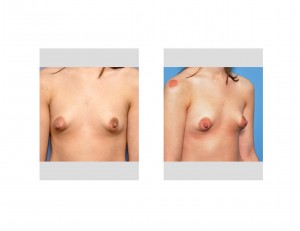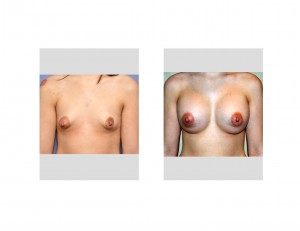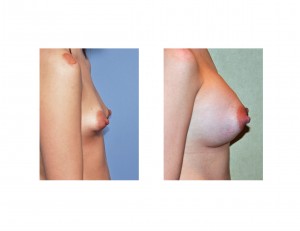Background: Breast augmentation largely exerts its effect by expanding the breast tissue under which it is placed. When the overlying breast tissue is good (reasonably tight skin and a centric nipple position) the resulting larger breast mound is very aesthetically pleasing. When the overlying breast tissue is flawed (loose sagging skin and a low nipple position), the breast mound may get bigger but it will be far less aesthetically pleasing. (the saggy breast tissue and nipple may well be pushed forward and down) In essence, a breast augmentation result is usually only as good as the breast tissues will allow.
In congenital breast abnormalities such as significant asymmetries and mound development deformities, the use of a breast implant alone helps but can not fully compensate for the breast tissue deficiencies. One of the most challenging of these congenital breast problems is the of the tuberous breast. It is a well recognized problem of which part of the problem is lack of adequate breast tissue development. But the tuberous breast is much more than a small or underdeveloped breast. The base of the breast is constricted and what breast tissue exists is pushed or herniated through the base of the areola. This creates a puffy areola that protrudes outward whose size may constitute nearly the entire breast mound. This puffy protruding areola create a tube-like breast appearance.
Tuberous breasts are not rare and, because of the very small breast size, commonly present for breast augmentation. It is estimated that between 1% to 5% of women who come in for breast augmentation are afflicted by some degree with this breast deformity. While breast implants are an integral part of tuberous breast surgery, release of the tight breast tissues and areolar reduction are often needed as well.



For most cases of tuberous breasts, implants alone are not usually adequate. A larger mound is needed but an implant will just push the small amount of breast tissue further through the areolar ring. The breast tissue needs to be scored and released through a periareolar approach. This corrects the areolar protrusion and expands out the tight breast tissue. But in smaller-sized tuberous breasts, an implant alone may create a satisfactory result if the patient is willing to accept a residual amount of areolar protrusion.
Case Highlights:
1) Tuberous breasts have an underdeveloped and abdnormally shaped mound which commonly presents for breast augmentation.
2) Depending upon the degree of areolar tissue herniation, breast implants alone may or may create a completely satisfactory shaped breast mound and nipple shape.
3) Tuberous breast surgery with implants should be viewed as a two-stage procedure, being prepared for the need for a revisional operation if necessary.
Dr. Barry Eppley
Indianapolis, Indiana


